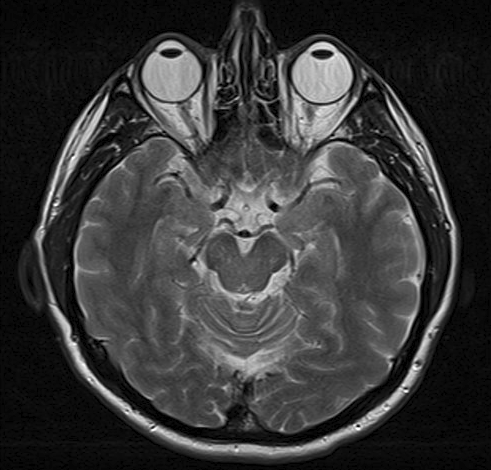MRI-Scan
Begutachtet von Dr. Colin Tidy, MRCGPZuletzt aktualisiert von Dr. Toni Hazell, MRCGPZuletzt aktualisiert am 7 Aug 2023
Erfüllt die Anforderungen des Patienten redaktionelle Richtlinien
- HerunterladenHerunterladen
- Teilen Sie
- Sprache
- Diskussion
Ein MRT-Scan ist eine sichere und schmerzlose Untersuchung, die detaillierte Bilder von Organen und anderen Strukturen in Ihrem Körper liefern kann.
Hinweis: Die nachstehenden Informationen sind nur ein allgemeiner Leitfaden. Die Vorkehrungen (und die Art und Weise, wie die Tests durchgeführt werden) können von Krankenhaus zu Krankenhaus unterschiedlich sein. Befolgen Sie immer die Anweisungen Ihres Arztes oder des örtlichen Krankenhauses. Diese sind in der Regel in Ihrem Terminschreiben enthalten.
In diesem Artikel:
Lesen Sie unten weiter
Was ist ein MRI-Scan?
MRI steht für Magnetresonanztomographie. Bei einer MRT-Untersuchung werden ein starkes Magnetfeld und Radiowellen eingesetzt, um ein detailliertes Bild auf einem Computerbildschirm zu erzeugen. Es kann verschiedene Arten von Gewebe, Organen und anderen Strukturen in Ihrem Körper zeigen.
Dieses Bild ist ein MRT-Scan eines Gehirns. Die Augäpfel der Person sind oben im Bild zu sehen.
MRI-Scan

Von Ptrump (Eigenes Werk) via Wikimedia Commons
Wie funktioniert ein MRI-Scan?
Ihr Körper enthält Millionen von Wasserstoffatomen. Wenn Sie in einem Kernspintomographen sind:
Ein starkes Magnetfeld richtet Teilchen aus, die Protonen genannt werden und sich in den Wasserstoffatomen befinden. Alle Protonen reihen sich parallel zum Magnetfeld auf, wie winzige Magnete. (Normalerweise liegen die Millionen von Protonen alle in zufälligen Richtungen.)
Dann werden kurze Radiowellenstöße vom Scanner in Ihren Körper gesendet. Die Radiowellen stoßen die Protonen aus ihrer Position.
Wenn der Ausbruch der Radiowellen aufhört, richten sich die Protonen wieder auf. Dabei senden sie Funksignale aus. Die Protonen in den verschiedenen Geweben des Körpers richten sich unterschiedlich schnell aus. Daher variiert das von den verschiedenen Körpergeweben ausgesandte Signal. So können beispielsweise weichere Gewebe anhand der ausgesandten Signale von härteren Geweben unterschieden werden.
Diese Signale werden von einer Empfangseinrichtung im Scanner erfasst.
Das Empfangsgerät überträgt die Signale an einen Computer. Der Computer erstellt ein Bild auf der Grundlage der vom Körper ausgesandten Funksignale.
Lesen Sie unten weiter
Wie läuft eine MRT-Untersuchung ab?
Der MRT-Scanner ist wie ein etwa 1,5 Meter langer Tunnel, der von einem großen runden Magneten umgeben ist. Man liegt auf einer Liege, die dann in den Scanner geschoben wird. Ein "Empfangsgerät", ähnlich einer Antenne, wird hinter oder um den zu untersuchenden Körperteil herum angebracht. Dieses Gerät empfängt die winzigen Funksignale, die von Ihrem Körper ausgesendet werden. Bei jeder "Aufnahme" müssen Sie einige Minuten lang stillhalten, da das Scanbild sonst unscharf sein kann.
Kernspintomograph

Von Jan Ainali (eigenes Werk) über Wikimedia Commons.
Der Scan selbst ist schmerzlos. Das gesamte Verfahren kann 15-40 Minuten dauern. Es kann ein wenig unangenehm sein, während dieser Zeit still auf der Liege zu liegen. Bei kleinen Kindern kann eine Vollnarkose erforderlich sein, damit sie lange genug stillhalten können, damit die Bilder gemacht werden können. Der Ort, an dem Sie liegen, ist ziemlich eng, was manche Menschen als sehr unangenehm empfinden.
Wenn Sie Angst vor engen Räumen(Klaustrophobie) haben, sollten Sie dies mit Ihrem Arzt besprechen, bevor Sie sich zur Untersuchung anmelden. In einigen Teilen des Landes gibt es "offene" Ultraschallgeräte. Sie sind jedoch nicht überall verfügbar und die Wartezeit für einen "offenen" Scanner ist in der Regel länger als für einen geschlossenen Scanner.
In einigen Fällen wird ein spezielles Kontrastmittel über eine Armvene in die Blutbahn gespritzt. Dadurch können bestimmte Gewebe oder Organe, die untersucht werden, deutlicher dargestellt werden.
Der Röntgenassistent sitzt im Kontrollraum neben dem Scanner und sieht durch das Fenster zu. Sie können jedoch mit ihm sprechen, normalerweise über eine Gegensprechanlage, und Sie werden jederzeit auf einem Monitor beobachtet.
Der Scanner ist laut, daher erhalten Sie Kopfhörer oder Ohrstöpsel, um Ihre Ohren vor dem Lärm zu schützen. Oft können Sie über die Kopfhörer Radio oder Musik hören.
Wozu dient eine MRT-Untersuchung?
Ein MRT-Scan kann klare Bilder von den meisten Teilen des Körpers erstellen. Daher ist sie aus allen möglichen Gründen nützlich, wenn andere Untersuchungen (wie Röntgenstrahlen) nicht genügend Informationen liefern.
Es wird häufig verwendet, um detaillierte Bilder des Gehirns und des Rückenmarks zu erhalten, um Anomalien und Tumore zu erkennen. Sogar gerissene Bänder um Gelenke können mit einer MRT-Untersuchung erkannt werden. Daher wird sie immer häufiger nach Sportverletzungen eingesetzt.
Gehirn
Die MRT ist die Untersuchung der ersten Wahl bei Hirntumoren, da sie klarere Bilder als die Computertomografie (CT) liefert und schwer zugängliche Bereiche des Gehirns zeigt. Es besteht ein deutlicher Kontrast zwischen Teilen der grauen und der weißen Substanz des Gehirns, was die MRT zur besten Wahl für viele andere Erkrankungen macht, darunter Multiple Sklerose, Schlaganfall, Alzheimer-Krankheit und Epilepsie.
Muskuloskelettales System
Hier wird die Wirbelsäule mit Hilfe der MRT untersucht, um Gelenkerkrankungen, Druck auf Nerven und Weichteiltumore zu beurteilen.
Gastrointestinales System
Die MRT ermöglicht eine nicht-invasive Beurteilung von entzündlichen Darmerkrankungen und Darmtumoren. Auch Probleme in der Leber und der Bauchspeicheldrüse können damit untersucht werden.
Blutgefäße und das Herz
Dies wird als Magnetresonanzangiographie (MRA) bezeichnet. Dabei werden Bilder der Arterien erstellt, um nach anormalen Verengungen oder Gefäßwanddilatationen (die zu platzen drohen) zu suchen. Die MRA wird häufig zur Untersuchung der Hals- und Hirnarterien, der Brust- und Bauchaorta, der Nierenarterien und der Beine eingesetzt. Sie kann auch zur Beurteilung angeborener Herzkrankheiten eingesetzt werden.
Lesen Sie unten weiter
Vorbereitungen für eine MRT-Untersuchung
Ihr örtliches Krankenhaus sollte Ihnen Informationen darüber geben, was erforderlich ist, bevor Sie zur Untersuchung kommen.
Der MRT-Scanner verwendet einen extrem starken Magneten, so dass Personen mit bestimmten Arten von medizinischen Implantaten nicht gescannt werden können. Der Grund dafür ist, dass der Magnet möglicherweise medizinische Geräte mit Metall darin bewegen oder ihre Funktion beeinträchtigen kann.
Bevor Sie den Scanbereich betreten, sollten Sie daher gefragt werden, ob Sie medizinische Geräte in Ihrem Körper tragen. Möglicherweise müssen Sie einen Sicherheitsfragebogen ausfüllen, in dem nach Dingen gefragt wird, die Metall enthalten könnten. Die folgende Liste ist nicht endgültig, aber sie kann Ihnen helfen, sich daran zu erinnern, über welche Dinge die Röntgenassistenten Bescheid wissen müssen:
Interner (implantierter) Defibrillator oder Herzschrittmacher.
Ohrimplantat (Cochlea).
Chirurgische Clips, wie sie bei Hirnaneurysmen verwendet werden.
Künstliche Herzklappen.
Implantierte Infusionsöffnungen für Medikamente.
Künstliche Gliedmaßen oder Metallgelenke.
Implantierte Nervenstimulatoren.
Stifte, Schrauben, Platten, Stents oder chirurgische Klammern.
Es ist auch wichtig, dem Röntgenassistenten mitzuteilen, ob Sie jemals Metallteile in Ihren Augen oder in Ihrem Körper hatten. In manchen Fällen müssen Sie vor einer MRT-Untersuchung geröntgt werden, um sicherzustellen, dass Sie sicher in den Scanner gehen können.
Nebenwirkungen einer MRT-Untersuchung
MRT-Untersuchungen sind schmerzfrei und gelten als sicher. Bei MRT-Untersuchungen werden keine Röntgenstrahlen verwendet, so dass die möglichen Bedenken, die mit Röntgenbildern und CT-Untersuchungen (die Röntgenstrahlen verwenden) verbunden sind, bei MRT-Untersuchungen nicht auftreten.
Allerdings:
In seltenen Fällen kommt es bei manchen Menschen zu Reaktionen auf das manchmal verwendete Kontrastmittel.
Schwangeren Frauen wird in der Regel von einer MRT-Untersuchung abgeraten, es sei denn, sie ist dringend erforderlich. Obwohl die Untersuchung als sicher gilt, sind die langfristigen Auswirkungen starker Magnetfelder auf ein sich entwickelndes Baby noch nicht bekannt.
Was Sie nach der MRT-Untersuchung erwartet
Es gibt keine Nachwirkungen des Scans. Sobald die Untersuchung beendet ist, können Sie zu Ihren normalen Aktivitäten zurückkehren. Die Bilder der Untersuchung werden von einem Spezialisten - einem Radiologen - ausgewertet, der einen Bericht an den Arzt schickt, der die Untersuchung angefordert hat.
In der Regel müssen Sie mindestens zwei Wochen warten, bis Sie Ihre Ergebnisse erfahren. Bei dringenden Befunden wird der Spezialist so schnell wie möglich informiert. Das Ergebnis wird an die Person zurückgesandt, die die Untersuchung angefordert hat. Wenn also ein Krankenhausarzt eine Untersuchung anfordert, erhalten Sie das Ergebnis bei Ihrem nächsten Termin bei ihm. Wenn Sie sich Sorgen machen, können Sie die Sekretärin anrufen, aber fragen Sie nicht den Hausarzt nach dem Ergebnis, da er es nicht haben wird. Wenn der Hausarzt ein MRT angefordert hat, erhalten Sie das Ergebnis von ihm.
Patientenauswahlen für Bildgebung

Tests und Untersuchungen
Zerebrale Angiographie
Cerebral angiography is a test that uses X-rays and a special dye to create pictures of the blood vessels that supply the brain. Note: the information below is a general guide only. The arrangements, and the way tests are performed, may vary between different hospitals. Always follow the instructions given by your doctor or local hospital.
von Dr. Mary Harding, MRCGP

Tests und Untersuchungen
CT-Untersuchung
Hinweis: Die nachstehenden Informationen sind nur ein allgemeiner Leitfaden. Die Vorkehrungen und die Art und Weise, wie die Tests durchgeführt werden, können von Krankenhaus zu Krankenhaus unterschiedlich sein. Befolgen Sie immer die Anweisungen Ihres Arztes oder des örtlichen Krankenhauses.
von Dr. Rachel Hudson, MRCGP
Weiterführende Literatur und Referenzen
- MRI-ScanKrebsforschung UK; 2022
Lesen Sie unten weiter
Artikel Geschichte
Die Informationen auf dieser Seite wurden von qualifizierten Klinikern verfasst und von Fachleuten geprüft.
Nächste Überprüfung fällig: 5. August 2028
7 Aug 2023 | Neueste Version

Fragen, teilen, verbinden.
Stöbern Sie in Diskussionen, stellen Sie Fragen, und tauschen Sie Erfahrungen zu Hunderten von Gesundheitsthemen aus.

Fühlen Sie sich unwohl?
Beurteilen Sie Ihre Symptome online und kostenlos
Sign up to the Patient newsletter
Your weekly dose of clear, trustworthy health advice - written to help you feel informed, confident and in control.
By subscribing you accept our Privacy Policy. You can unsubscribe at any time. We never sell your data.